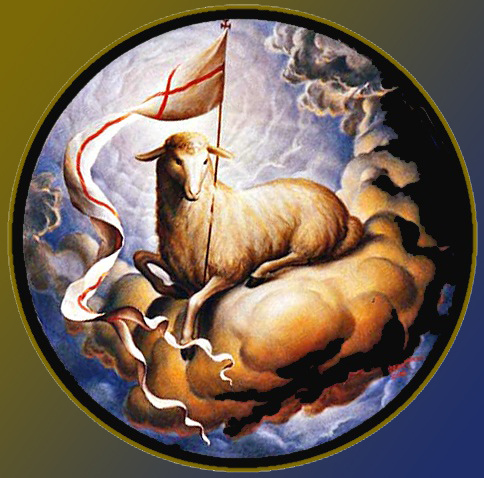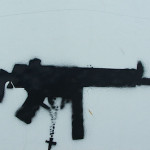We run our website the way we wished the whole internet worked: we provide high quality original content with no ads. We are funded solely by your direct support. Please consider supporting this project.

The Key to Understanding Revelation
The most important key to interpreting John’s violent imagery is found in the heavenly throne room scene in chapters 4-5. (For the first entry in this series on the violence in Revelation, click here.) This throne room represents heaven’s perspective on events that are occurring on earth, which is contrasted throughout Revelation with the false perspective of the “inhabitants of the earth” (8:13; 11:10; 13:8, 12, 14; 17:2). The only real battle that is waged throughout Revelation is a battle between truth and deception. It is, more specifically, a battle between the truth that the Lamb’s slaughtering was victorious and the lie that it was the Lamb’s defeat.
John invites us to see the truth by allowing us to witness the drama that is unfolding in the heavenly throne room. Here we find a mysterious sealed scroll, which contains the secret that Revelation unveils. The drama of this scene reaches a pinnacle when someone raises the question: “Who is worthy to break the seals and open the scroll?” (5:2). John weeps when no one is found worthy (5:4). How long before we learn the secret of the role that Jesus’ martyrdom plays in God’s victory over evil?
The answer is finally brought forth when John hears “one of the elders” in the throne room declare that “the Lion of the tribe of Judah, the Root of David, has triumphed,” and he is therefore worthy “to open the scroll and its seven seals” (5:3-5). This image represents the kind of enemy-slaying Messiah most first century Jews had been hoping for. But, surprisingly enough, when John looks to see this mighty messianic Lion, he instead beholds a little lamb that had already been slaughtered (5:6)!
Yes, John is saying, the Lion of the tribe of Judah has “triumphed,” but he triumphed not by violently slaying his enemies: he triumphed by becoming a slain little Lamb who offered up his life on behalf of his enemies. And yes, Jesus wages war with the aggression of a Lion, but the power that he aggressively wields is the Lamb-like power of self-sacrificial love that was perfectly manifested on the cross. In this way, John has transformed an image of power and domination into an image of vulnerability and nonviolence.
It is hard to overstate the importance of this remarkable symbolic transformation for our interpretation of Revelation. John’s transformation of the Lion of Judah into the sacrificial Lamb constitutes the climactic turn that anchors most of John’s other symbolic reversals. Once the Lion has been revealed to be the Lamb, we never again find Christ referred to as a Lion, though he’s referred to as the Lamb twenty-seven more times. Indeed, it is not an overstatement to say that the rest of the book of Revelation is simply an unfolding of the Lamb-like victory revealed in Revelation 5 and depicted (from a different angle) in Revelation 12. The remainder of Revelation, in other words, is an apocalyptic-like expression of the heavenly truth — spoken against all lies to the contrary — that by means of Jesus’ sacrificial death and the faithfulness of his followers, the “kingdom of the world has become the kingdom of our Lord and of his Messiah” (11:15).
Photo credit: Waiting For The Word via Visualhunt / CC BY
Category: General
Tags: Book of Revelation, End Times, Jesus, Violence
Topics: Biblical Interpretation
Related Reading

Making God in Our Own Image
In this video, Greg introduces the idea of how we make God into our own image instead of allowing God to define himself through the revelation of Jesus. In an interview performed by Travis Reed from theworkofthepeople.com, we have a basic, quick introduction to a core element of Greg’s theology. This is a great piece to…

Reflections on the Supremacy of Christ (Part 2)
Whereas most Christians place the revelation of God in Christ alongside of other portraits of God and end up with an amalgamated image of God, we at ReKnew encourage believers to base their understanding of God completely on Christ, and especially on Christ crucified. And we encourage disciples to work to reinterpret through the lens…

Does the Old Testament Justify “Just War”?
Since the time of Augustine, Christians have consistently appealed to the violent strand of the Old Testament to justify waging wars when they believed their cause was “just.” (This is Augustine’s famous “just war” theory.) Two things may be said about this. First, the appeal to the OT to justify Christians fighting in “just” wars…

In the Wilderness of Religion
Eric Bryan via Compfight There are an awful lot of us in the Church today who are no longer feeling at home in Evangelicalism. Regardless of how you feel about World Vision’s hiring policy decisions, the spectacle of thousands of people discontinuing their child sponsorships (relationships with flesh and blood children in need) because of…

The God Who Embraces Our Doubt
Lawrence OP via Compfight Zack Hunt over at The American Jesus posted some of his thoughts on doubt, and it seemed fitting on this week before the Doubt, Faith & the Idol of Certainty conference to share what he had to say. We’re thinking he must have stumbled on Greg’s book or maybe God is…
